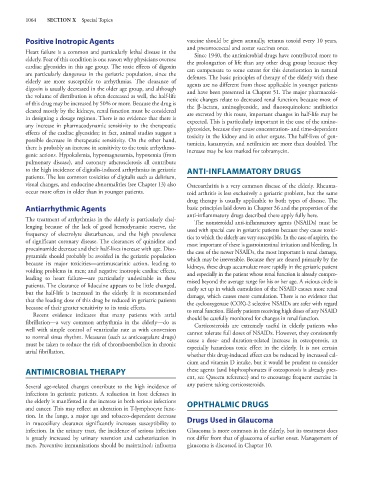Page 1078 - Basic _ Clinical Pharmacology ( PDFDrive )
P. 1078
1064 SECTION X Special Topics
Positive Inotropic Agents vaccine should be given annually, tetanus toxoid every 10 years,
and pneumococcal and zoster vaccines once.
Heart failure is a common and particularly lethal disease in the Since 1940, the antimicrobial drugs have contributed more to
elderly. Fear of this condition is one reason why physicians overuse the prolongation of life than any other drug group because they
cardiac glycosides in this age group. The toxic effects of digoxin can compensate to some extent for this deterioration in natural
are particularly dangerous in the geriatric population, since the defenses. The basic principles of therapy of the elderly with these
elderly are more susceptible to arrhythmias. The clearance of agents are no different from those applicable in younger patients
digoxin is usually decreased in the older age group, and although and have been presented in Chapter 51. The major pharmacoki-
the volume of distribution is often decreased as well, the half-life netic changes relate to decreased renal function; because most of
of this drug may be increased by 50% or more. Because the drug is the β-lactam, aminoglycoside, and fluoroquinolone antibiotics
cleared mostly by the kidneys, renal function must be considered are excreted by this route, important changes in half-life may be
in designing a dosage regimen. There is no evidence that there is expected. This is particularly important in the case of the amino-
any increase in pharmacodynamic sensitivity to the therapeutic glycosides, because they cause concentration- and time-dependent
effects of the cardiac glycosides; in fact, animal studies suggest a toxicity in the kidney and in other organs. The half-lives of gen-
possible decrease in therapeutic sensitivity. On the other hand, tamicin, kanamycin, and netilmicin are more than doubled. The
there is probably an increase in sensitivity to the toxic arrhythmo- increase may be less marked for tobramycin.
genic actions. Hypokalemia, hypomagnesemia, hypoxemia (from
pulmonary disease), and coronary atherosclerosis all contribute
to the high incidence of digitalis-induced arrhythmias in geriatric ANTI-INFLAMMATORY DRUGS
patients. The less common toxicities of digitalis such as delirium,
visual changes, and endocrine abnormalities (see Chapter 13) also Osteoarthritis is a very common disease of the elderly. Rheuma-
occur more often in older than in younger patients. toid arthritis is less exclusively a geriatric problem, but the same
drug therapy is usually applicable to both types of disease. The
Antiarrhythmic Agents basic principles laid down in Chapter 36 and the properties of the
anti-inflammatory drugs described there apply fully here.
The treatment of arrhythmias in the elderly is particularly chal- The nonsteroidal anti-inflammatory agents (NSAIDs) must be
lenging because of the lack of good hemodynamic reserve, the used with special care in geriatric patients because they cause toxici-
frequency of electrolyte disturbances, and the high prevalence ties to which the elderly are very susceptible. In the case of aspirin, the
of significant coronary disease. The clearances of quinidine and most important of these is gastrointestinal irritation and bleeding. In
procainamide decrease and their half-lives increase with age. Diso- the case of the newer NSAIDs, the most important is renal damage,
pyramide should probably be avoided in the geriatric population which may be irreversible. Because they are cleared primarily by the
because its major toxicities—antimuscarinic action, leading to kidneys, these drugs accumulate more rapidly in the geriatric patient
voiding problems in men; and negative inotropic cardiac effects, and especially in the patient whose renal function is already compro-
leading to heart failure—are particularly undesirable in these mised beyond the average range for his or her age. A vicious circle is
patients. The clearance of lidocaine appears to be little changed, easily set up in which cumulation of the NSAID causes more renal
but the half-life is increased in the elderly. It is recommended damage, which causes more cumulation. There is no evidence that
that the loading dose of this drug be reduced in geriatric patients the cyclooxygenase (COX)-2 selective NSAIDs are safer with regard
because of their greater sensitivity to its toxic effects. to renal function. Elderly patients receiving high doses of any NSAID
Recent evidence indicates that many patients with atrial should be carefully monitored for changes in renal function.
fibrillation—a very common arrhythmia in the elderly—do as Corticosteroids are extremely useful in elderly patients who
well with simple control of ventricular rate as with conversion cannot tolerate full doses of NSAIDs. However, they consistently
to normal sinus rhythm. Measures (such as anticoagulant drugs) cause a dose- and duration-related increase in osteoporosis, an
must be taken to reduce the risk of thromboembolism in chronic especially hazardous toxic effect in the elderly. It is not certain
atrial fibrillation.
whether this drug-induced effect can be reduced by increased cal-
cium and vitamin D intake, but it would be prudent to consider
ANTIMICROBIAL THERAPY these agents (and bisphosphonates if osteoporosis is already pres-
ent, see Qaseem reference) and to encourage frequent exercise in
Several age-related changes contribute to the high incidence of any patient taking corticosteroids.
infections in geriatric patients. A reduction in host defenses in
the elderly is manifested in the increase in both serious infections OPHTHALMIC DRUGS
and cancer. This may reflect an alteration in T-lymphocyte func-
tion. In the lungs, a major age and tobacco-dependent decrease
in mucociliary clearance significantly increases susceptibility to Drugs Used in Glaucoma
infection. In the urinary tract, the incidence of serious infection Glaucoma is more common in the elderly, but its treatment does
is greatly increased by urinary retention and catheterization in not differ from that of glaucoma of earlier onset. Management of
men. Preventive immunizations should be maintained: influenza glaucoma is discussed in Chapter 10.

